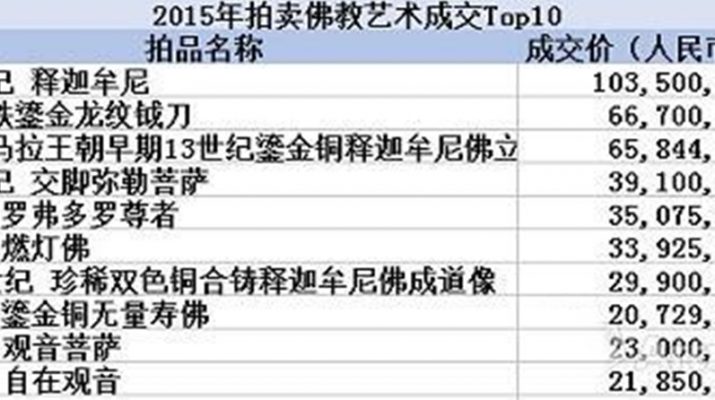
12月7日,北京保利十周年秋拍“过去佛,现在佛,未来佛——Speelman秘藏梵像聚珍”专场在北京四季酒店举槌,共推出朱勒斯•斯彼尓曼(Jules Speelman)珍藏的12件佛像,其中,十四世纪释迦牟尼以估价待询形式上拍,3800万元起拍,9000万元落槌,成交价达到1.035亿元。
此尊铜鎏金“十四世纪释迦牟尼”重38.1千克,曾于2013年在首都博物馆举办的《佛韵-造像艺术集粹展》中展出。1961年进入欧洲重要私人收藏,先后成为乌尔里希•冯•施罗德(Ulrich von Schroeder)和贝蒂•阿什曼(Berti Aschmann)旧藏。2008年3月19日,这尊十四世纪释迦牟尼佛像在纽约苏富比上拍,之后由朱勒斯•斯彼尓曼(Jules Speelman)珍藏。
此尊十四世纪释迦牟尼佛表现了释迦在菩提迦耶大菩提树下成道时的情景。据佛传故事,释迦牟尼佛在菩提树下入定,不为美色妖魔所动,战胜魔军,开悟菩提,一手禅定,一手触地,所以此种姿态,亦称成道像。
红铜鎏金单体浇铸 欧洲私人收藏 像高 35cm
这是一尊释迦牟尼佛标准的成道像,佛陀左手平伸结禅定印,右手下垂自然弯曲结触地印,这是佛陀成道时所结的印相,能制服一切诸魔。佛祖宝珠顶严,肉髻高隆,大耳垂肩、弯眉长目,双目微垂,额间突出有硕大的水滴形白毫,五官刻画准确,面相祥和庄严。身着袒右式袈裟,薄衣贴体,无衣服褶皱雕刻,只在袈裟边缘及袖口饰双连珠文绦带,中间阴刻卷草纹。佛陀身材健硕,胸臂浑圆结实,挺拔伟岸,强烈的内在力度通过轻薄透剔的袈裟彰显无遗。
雕塑技艺洗练简洁,使佛像洋溢着充沛的活力,达到生动传神的艺术效果。束腰仰覆式莲花座,造型大气,莲瓣饱满圆润,制作精当,具有藏中地区艺术特点。此尊造像红铜铸造,鎏金亮丽,用材讲究,工艺精湛,是西藏本土艺术吸取汉地、尼泊尔艺术,走向成熟时期的佳作。
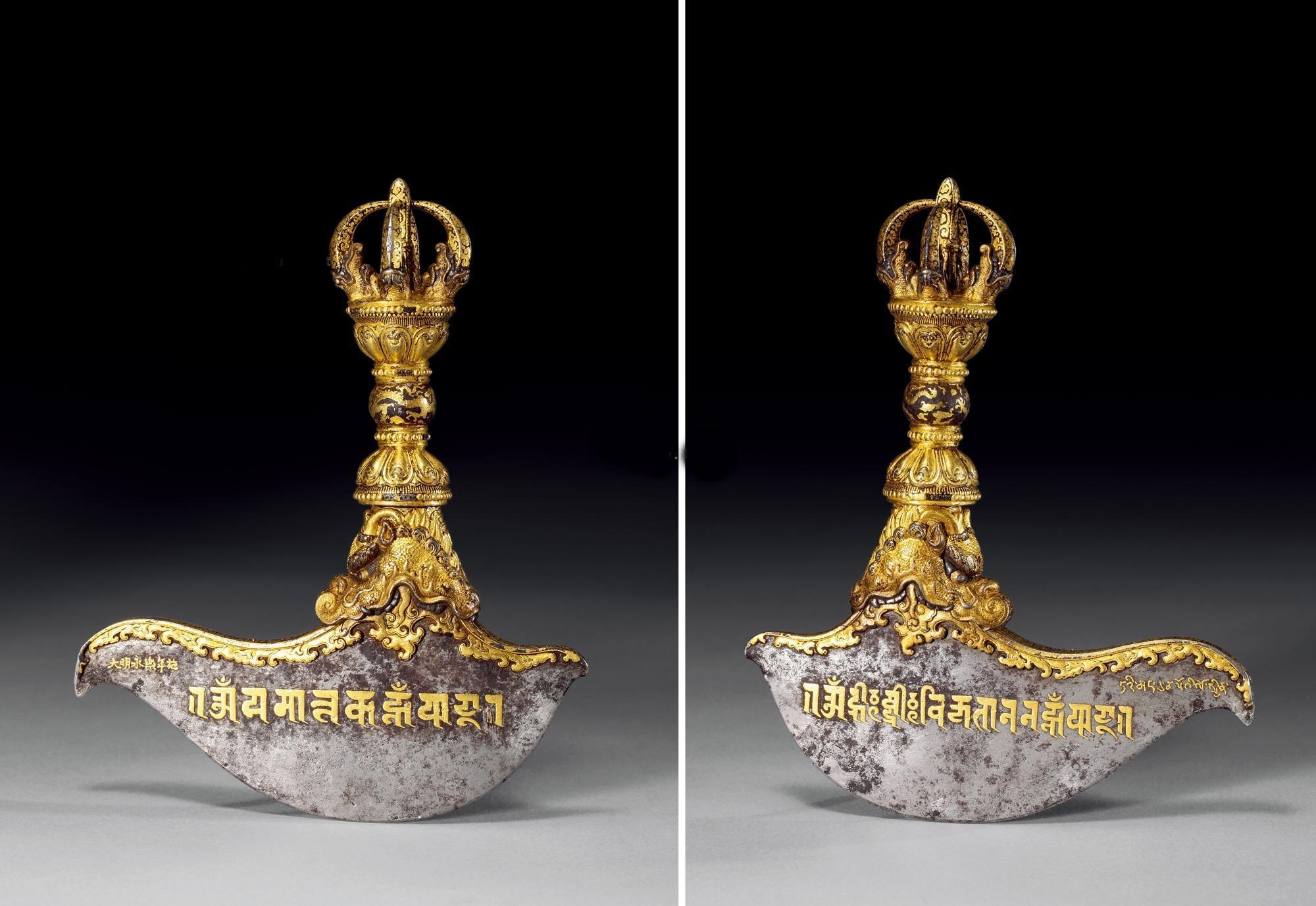
*2863 明永乐 铁鎏金龙纹钺刀
拍品信息
作者 — 尺寸 高17cm
作品分类 工艺品杂项>工艺品其它 创作年代 明永乐
估价 咨 询 价
成交价
RMB 66,700,000 HKD 81,242,387USD 10,005,000EUR 7,337,000
专场 中国古董珍玩 拍卖时间 2015-11-28
拍卖公司 北京翰海拍卖有限公司 拍卖会 2015秋季拍卖会
说明 “大明永乐年施”楷书款
此件钺刀由两部分组成,第一部分是作为手柄的五钴金刚杵,第二部分为摩羯及其口吐的钺刀刀身,此组合为典型的藏传佛教仪轨之法器。
上部的五钴金刚杵钴叉聚拢,合而为一,为最常见的使用形式,其中央矗立一个中轴钴叉,在四大方位上分别有一弯曲型钴叉,四个外钴叉分别从摩羯口中伸出,也称作金刚舌,与中央连为一体,其象征着“四无量”、“四解脱门”、降服令人苦恼的“四魔”(烦恼魔、阴魔、死魔、他化自在)、战胜“四业”(息业、增业、怀业、诛业)。四个外钴叉与中心钴叉连为一体,同时象征着色、受、想、行四蕴是以第五蕴“识”为依据,隐喻佛陀引导世人摆脱轮回之苦的“八正道”。钴叉下方为一对称的结构,中心圆形位置为法尔,即自然、本性或规律,其具象的将此概念比作空性,其上下各有三层连珠装饰的部分,这三个层次象征着“空解脱门”、“无相解脱门”及“无愿解脱门”,由空性中生成,其上各有八瓣莲花座一个,上方八个莲瓣象征八大男性菩萨,下方八个莲瓣象征着八大天女或女性菩萨,十六个莲瓣统合为十六菩萨和大乘经罗列的十六空,两个莲花座上方又有一组三层结构,分别为莲蕊、宝珠及圆台,上下两个圆台分别象征着太阳与月亮,代表方便和智慧,相对与绝对真理的结合,俗谛与真谛的合一。
第二部分则为摩羯与刀刃,摩羯的形象出现在很多密教法器之上端,既是装饰,同样也是极具象征意义的存在,它在很多佛教艺术作品中,往往省略了身体部分,转而竭力夸张的表现其首部阔开的巨口,而金刚杵钴叉、钺刀等法器,往往由此巨口中生出,暗示兵刃被赋予了强大的能量,坚不可摧。其艺术形象也常出现在佛座及上师的背光两侧上方或坛城四门的上方,犹如拱门。摩羯纹饰渊源于古印度传说,它是一种被认为拥有超凡力量的海中之兽,更有一种说法是“一切神都是从它的嘴里产生”,因此将之称为“神的帽子”。西藏喇嘛相信,摩羯可以呼风唤雨,并能一并带来火焰与烟雾,行法于千里之外。自摩羯口中展开的刀刃,前端弯曲,曲刃丰满,刀身正反两面均以错金工艺做金刚真言,正面为大威德金刚八字真言,刀勾处做汉字“大明永乐年施”楷书款,另面刀身为大威德金刚根本心咒十一字真言,刀勾处做“大明永乐年施”藏文拼音款。
这件钺刀的整体构造与制作工艺显示了明代御用监工匠纯熟的工艺与高超的艺术水准,为明代宫廷藏传佛教法器的典范之作,铁是打造法器的最佳材质,藏地认为铁源于佛陀的赐予(陨铁),其在掠过天际之时于虚空中燃烧,化为流星坠地,隐喻着佛法中色与空的不可分割性,因而众多法器会以铁为原料制作,此件法器通身为铁质打造,其上以错金银工艺密布了繁复精致的花纹,从钴叉的卷草纹饰到摩羯层层密布的鳞片,再到错金龙纹,无不体现着它在工艺上的登峰造极;而自然灵动的曲线与造型,挺括庄严的张力,又不可比拟的站在了佛教法器艺术的顶峰,令人心驰神往。
美国旧金山亚洲艺术馆和纽约大都会博物馆都收藏有明代永乐时期宫廷所造铁错金藏传佛教密教法器,故宫收藏一尊铁错金大黑天造像。由于铁错金工艺十分复杂,即便在明代宫廷之中,也会被尊为珍贵的法器。然而六百年的光阴荏苒,永乐帝虔心布施于藏地佛教领袖的雕像及法器,经历过嘉靖朝崇道抑佛之举以及时光中的各种洗礼,百不存一,虽钺刀仍流布于世,但铭有“大明永乐年施”款的错金银金刚钺刀,迄今仅见此一件。
金刚钺刀(梵文:Vajra Tomahawk;藏文:Trigug)是藏传佛教常见的法器,表神圣佛法不容侵犯,卫护佛法之心。藏传佛教的虎面空行母、狮面空行母、大威德金刚等造像,均有手持钺刀的形象。钺刀常常带有尖利扁平的蓝色铁身,末端有一个弯钩。其最初的含义为劈砍,刮,勾等动作,后引申为断灭一切情感与感知的智慧。锋利的刀身可以彻底断灭两大“障蔽”即“烦恼障”、“所知障”,从而获得圆满。在修行中刀身还可斩断六蔽,即“悭贪、破戒、嗔恚、懈怠、散乱、愚痴”,使人进入禅修状态。在愤怒像金刚手中,钺刀则象征断灭一切观念的方法。
永乐皇帝与藏传佛教之间的因缘颇为深刻,他作为燕王入驻北平之时,城内众多寺庙居住有很多避祸归隐的前朝国师及高僧,朱棣就藩之后常常幽游其间,而这些高僧多为藏地喇嘛,久而久之便日渐崇信藏传佛教。靖难之役过后,朱棣改元永乐,出于经略藏地以及通过宗教标榜自身正统身份的考虑,永乐帝诏令司礼监派遣官员及僧人入乌斯藏礼请高僧入京,除加封国师之外,更以优厚之礼物回赐,自此,秉承“众封多建”之策,永乐皇帝对于藏地来京觐见的西藏高僧来者不拒,全部加以封赏,历数年而基本控制藏地,《明史》载:“初,太祖以西番地广,人犷悍,欲分其势而杀其力,使不为边患,故来者辄受官。迨成祖,益封法王及大国师、西天佛子等,侔转相化导,以共尊中国,以故西陲晏然,终明世无番寇之患。”为了显示“向佛之心”与“皇道正统”,永乐对乌斯藏的封赏与规模无出其右。《明史》载:“成祖兼崇其教,自阐化等五王及二法王外,受西天佛子者二,灌顶大国师者九,灌顶国师者十有八,其它禅师、僧官不可悉数。”为满足如此众多之封赏,永乐朝设御用监佛作,制作了形制丰富,工艺登峰造极的各式佛像以及法器,作为大明威严的延伸,以“施”的方式广布川、藏、青等地及京师的宗教领袖,持久而深刻的影响着一世一代的审美,其造像法器的制作融汇了东西方造像艺术的精华,让佛理、仪轨、度量等等抽象的概念得以具体化,以其在中国造像工艺史中的巅峰地位,诠释了完美与辉煌的定义。
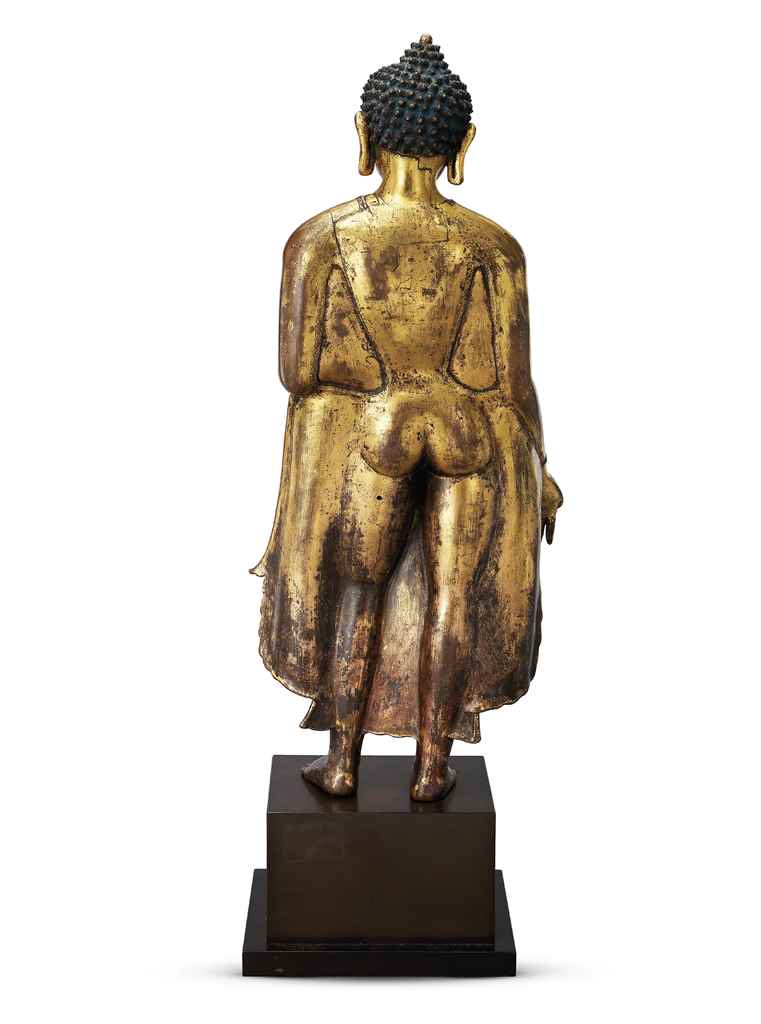
2902 尼泊尔 马拉王朝早期 13世纪 鎏金铜释迦牟尼佛立像
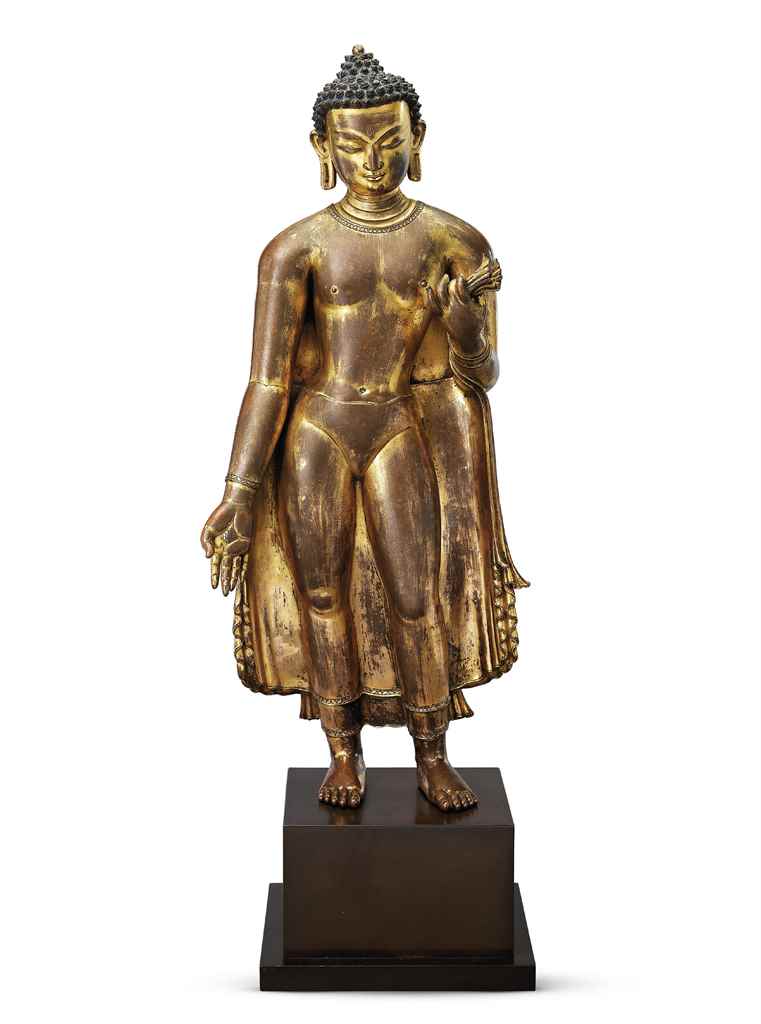
2902 尼泊尔 马拉王朝早期 13世纪 鎏金铜释迦牟尼佛立像
拍品信息
作者 — 尺寸 高50.8cm
作品分类 佛教文物>佛教文物其它 创作年代 尼泊尔 马拉王朝早期 13世纪
估价 HKD 32,000,000-50,000,000
成交价
RMB 65,844,200 HKD 80,200,000USD 10,265,600EUR 8,020,000
专场 大俱足 – 经典亚洲佛教艺术 拍卖时间 2015-12-02
拍卖公司 佳士得香港有限公司 拍卖会 2015年秋季拍卖会
说明 佛陀立姿,双脚分开,微呈三屈式,右手垂下施与愿印,左手内弯抓住衣襬,手指刻划细腻,掌心刻法轮印。下身系兜提,外罩薄袈裟,衣领、衣襬有刻花纹饰。开脸周缜入微,端凝英挺,修目丰唇,眉间有一丛螺旋状的白毫。头发亦呈螺旋状小卷,高耸至头顶顶髻,有鎏金宝珠顶。全身鎏金灿然,磨损处显露红铜铜质。
出处
欧洲私人基金会珍藏,于1985 年前入藏
文字介绍
J. Casey Singer,《Divine Presence: Arts of India & the Himalayas》,米兰,2003 年,131 页,图版39 号
已展出
借展予大都会博物馆,纽约,1985 年3 月15 日—1992 年6 月9 日
巴塞隆拿Casa Asia,《Divine Presence: Arts of India and the Himalayas》,2003年3月27-6月22日,图录图版39号
N IMPORTANT GILT-BRONZE FIGURE OF BUDDHA SHAKYAMUNI
NEPAL, EARLY MALLA PERIOD, 13TH CENTURY
Price realised
HKD 80,200,000
Estimate
HKD 32,000,000 – HKD 50,000,000
Add to Interests
AN IMPORTANT GILT-BRONZE FIGURE OF BUDDHA SHAKYAMUNI
NEPAL, EARLY MALLA PERIOD, 13TH CENTURY
The Buddha stands in slight tribhanga with his right hand lowered in varadamudra and the left holding the folds of his robes, each hand with delicately articulated fingers and with a chakra incised on the palm. He wears a long dhoti beneath a slightly shorter sanghati, and both garments are incised on the hems, which are visible at the neck, wrists and calves.. The face is exquisitely modeled with full lips, aquiline nose and elongated eyes with incised pupils beneath finely wrought eyebrows centered by a spiral urna. The pattern is echoed in the spiral hair tufts rising to an ushnisha topped with a gilt knop. The figure is beautifully gilt overall with the richly patinated copper showing through.
20 in. (50.8 cm.) high
Lot essay
Standing gilt-bronze figures of Buddha Shakyamuni of this age, stature, and importance rarely appear on the market. Compare with a similarly-dated gilt-bronze figure of Avalokiteshvara, slightly larger in size than the present figure, from The Collection of Robert H. Ellsworth, sold at Christie’s New York, 17 March 2015, lot 25 (Fig. 1). See, also, a gilt-bronze figure of Padmapani from The Doris Wiener Collection, sold at Christie’s New York, 20 March 2012, lot 92 (Fig. 2). Also note a smaller, 14th century seated figure of a crowned Buddha, sold at Christie’s New York, 19 March 2014.
Cataloguing & details
Provenance
Collection of a private foundation, Europe, by 1985
Private collection, New York, acquired from Sotheby’s New York, 16 September 1998, lot 62
Literature
J. Casey Singer, et al., Divine Presence: Arts of India and the Himalayas, Milan, 2003, p. 131, cat. no. 39
Exhibited
The Metropolitan Museum of Art, New York, 15 March 1985 – 9 June 1992
Barcelona, Casa Asia, Divine Presence: Arts of India and the Himalayas, 27 March-22 June 2003, cat. no. 39
Post Lot Text
Standing Buddhas usually portray Shakyamuni, the historic Buddha, and are one of the most iconic images of South Asian Buddhism. Therefore, it is curious that they are a somewhat rare genre among the cast copper images of Nepal where bodhisattvas are more common. This example, one of the finest known, is both large in size and exquisitely modeled. It was on loan to The Metropolitan Museum of Art from March 1985 to June 1992 and displayed on the Great Hall Balcony. In order to understand the ways in which the earlier model has been subtly modified to manifest Nepalese taste and spirit, it is worth considering Indian Gupta prototypes.
There, the Buddha stands in a frontal static posture which is softened by a slight bend to his right leg at the knee, creating a subtle lilt to his posture. For example, see a 6th century standing Buddha from the Rockefeller Collection, now at Asia Society (see D. Leidy, Treasures of Asian Art: The Asia Society’s Mr. and Mrs. John D. Rockefeller 3rd Collection, New York, 1994, pp. 28-30). If his head were not straight this would be a typical tribhanga, a thrice-bent posture where the legs, torso and head are shown in opposition. Typically, a long robe consisting of a wrapped length of fabric is draped across his broad shoulders and forms a loose opening below his neck. One end of the fabric is stretched across his left shoulder and then falls behind across his left shoulder blade. In some images, the outer robe falls across the torso and legs in a series of parallel folds that visually dematerializes the Buddha’s body, a feature that comes out of Mathura prototypes. In other examples, such as the sculpture from the Sarnath school, the fabric clings tightly to the body, materializing from the negative space of nearly equal size between the arms and body. For an example, see a 5th century sandstone figure of the Buddha at The British Museum (Asia OA 1880-6). In both models, a second garment appears beneath, whose upper hem can be seen through the first as a line above the hips and whose lower edge emerges just below the outer robe. Typically, his forearms are parallel to the ground and the left hand holds the gathered terminus of one end of his robe, while his right one is raised, palm forward, in a gesture to allay fear, or abhayamudra. Frilly pleats of fabric puddle near the lower hem of the robe below both of his raised forearms.
Our Nepalese Buddha, which undoubtedly derives from these earlier examples, departs from this canon in interesting ways. The figure displays a strong tribhanga, the head and hips tilts to his right, while the torso opposes them lilting to his left. The left forearm and hand are positioned higher than usual, so that the gathered robe end is practically at shoulder level. The Buddha’s right hand has dropped to his side, and is positioned in varadamudra, the boon bestowing gesture. The robe is more tightly cinched around the neck like a collar and there is no fold indicating that one end falls across his back. Instead, the emphasis has been placed on the billowing hem which gently wraps around the left arm, ending in a tuft of fabric held in the hand. The neckline and hems of the robes are articulated with a small border design of opposing, tilted lozenges. As the right hand is lowered and the curve of the body so exaggerated, the negative spaces on either side of the body are unequal, with the right side being more prominent. The outline of the bronze is more animated than that of its prototype. The robust chest and thighs are accentuated by the cinched waist, creating a form infused with youthful energy. For a sculpture with similar proportions, see a 14th century figure of Avalokiteshvara in the Victoria and Albert Museum (IM 239-1922). Details of the draped anatomy of the Buddha are more clearly visible: features that are usually obscured by the cloth such as the nipples, and belly button are clearly visible. The beautiful head has arched eyebrows, elongated eyes, hooked nose and pursed lips typical of the Early Malla style. The Buddha’s urna, third eye, is shown atypically as an engraved spiral rather than a raised dot.
The Nepalese sculptor has created a unique variation on one of the most important images in Buddhism. The large scale, beautiful casting and exquisite finishing are commensurate with the finest tradition of renowned Nepalese craftsmanship. The volumes of the figure are skillfully balanced to create a sensual and joyous image. The sculpture was originally gilded overall and repeated handling has, overtime, worn away areas of the gold, revealing the exquisitely rich copper patina underneath. The face largely retains its original surface treatment and the hair has blue pigment between the hair curls, surely a sign that this sculpture was venerated in Tibet for a time.
Steven M. Kossak
Former curator, Department of Asian Art,
Metropolitan Museum of Art
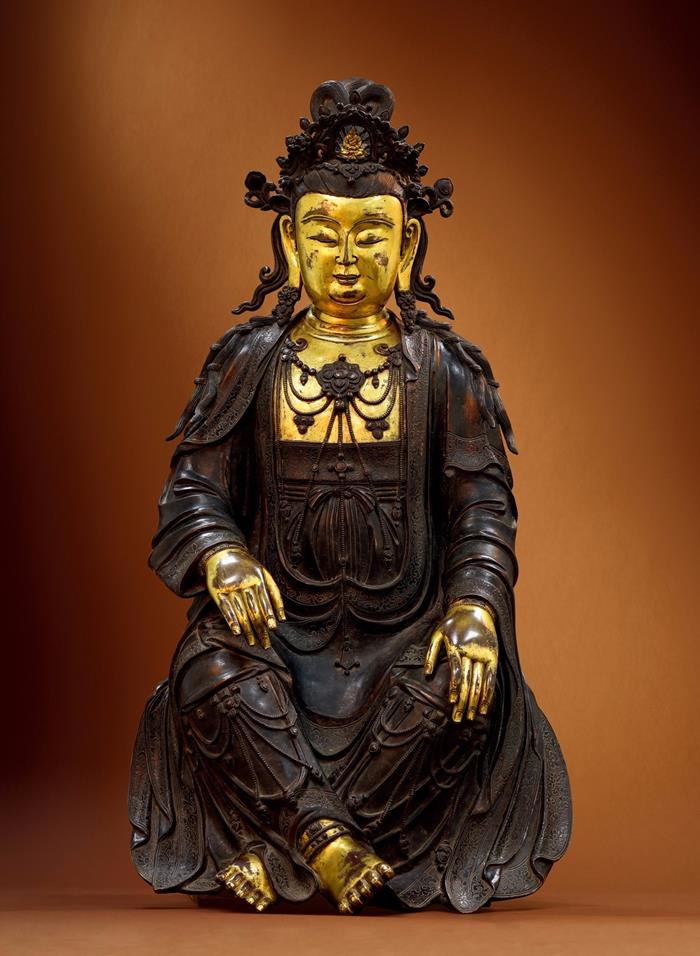
高87cm
重53.8kg
RMB 39,100,000
北京保利国际拍卖有限公司 > 北京保利十周年秋季拍卖会 > 过去佛,现在佛,未来佛——Speelman秘藏梵像聚珍
7334 十三世纪 交脚弥勒菩萨
拍品信息
作者 — 尺寸 高87cm
作品分类 佛教文物>佛教文物其它 创作年代 十三世纪
估价 咨 询 价
成交价
RMB 39,100,000 HKD 47,624,848USD 5,865,000EUR 4,301,000
专场 过去佛,现在佛,未来佛——Speelman秘藏梵像聚珍 拍卖时间 2015-12-07
拍卖公司 北京保利国际拍卖有限公司 拍卖会 北京保利十周年秋季拍卖会
出版:《佛韵-造像艺术集粹展》,文物出版社,46页。
说明 合金铜、局部鎏金
来源:1.朱勒斯.斯彼尓曼(Jules Speelman)珍藏
2.美国洛杉矶Butterfields拍卖 1999年10月12日
3.1970年代,美国加利福尼亚私人收藏展览:首都博物馆《佛韵-造像艺术集粹展》2013年11月8日-11月28日
此尊元代交脚弥勒束髪高髻,头戴花叶宝冠,中间有一鎏金化佛,缯带与髪辫沿耳后披于两肩,髪丝刻划精细,双耳皆佩花叶嵌宝石耳饰,上身着双领下垂式天衣,内着袈裟束于腹前,天衣与袈裟边缘均錾刻精美锦地莲花卷草纹饰,胸前佩莲花项链,并以之为中心饰伞状连珠式璎珞,袈裟及下裙上亦垂挂连珠式璎珞,佛光宝气,精美异常,且以其尺寸及做工来看,除由皇室施造并供奉外难有别种可能,可谓气势撼人,同时期之作品可参考现藏于首都博物馆一尊尺寸与之相比较小但也同样震撼之元代影青水月观音倚坐像,二者在髪冠、面容、坠饰和身材比例等多处皆极为相似,因此尊水月观音为1955年出土于北京西城区定阜大街,为元大都城址范围内出土,据此判断此尊交脚弥勒或可为同时期元大都供奉之珍品(图片1)。
重53.8千克
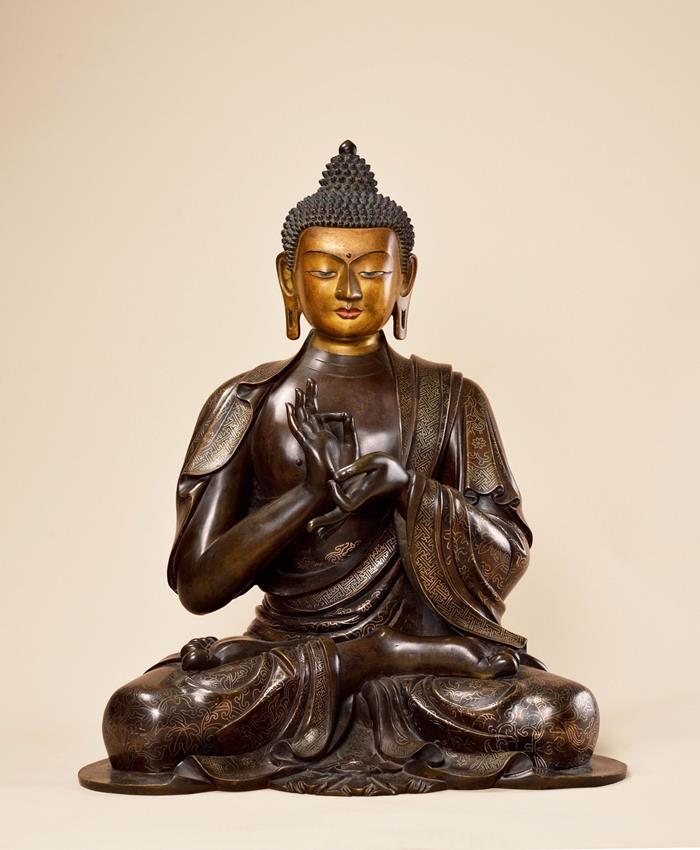
高 51cm
重45.2kg
RMB 33,925,000
清乾隆 燃燈佛
合金銅、嵌紅銅及銀
高 51厘米?重45.2千克
RMB 33,925,000
來源:朱勒斯.斯彼尓曼(Jules Speelman)珍藏
展覽:首都博物館《佛韻-造像藝術集粹展》2013年11月8日-11月28日
出版:《佛韻-造像藝術集粹展》,文物出版社,231頁。
參閱:威廉.華生,何翠媚《1620年以來的中國藝術》耶魯大學出版社,2007年,102頁,圖片133
本季秋拍將獻上Jules Speelman先生典藏佛教藝術品專拍,藉由Speelman歷經數十年心力薈集而成的這一批極具“學者品味”的佛教瑰寶,不僅可領略造像的藝術之美,感受其中凝聚的深刻宗教感情,更可由收藏家對三件最重要的藏品-“過去佛,現在佛,未來佛”的精心歸納甄選一窺佛教力求超脫“三千大千世界”的宗教理念。
“過去佛”即為燃燈佛,為釋迦牟尼之前的佛,佛經中記載燃燈佛出生時身邊一切光明如燈,故稱為燃燈佛。佛經中將一個宇宙從生到滅稱為一個“大劫”,釋迦牟尼所在的現世即現在的劫稱為“賢劫”,燃燈佛為賢劫之前“莊嚴劫”的佛。燃燈佛曾預言釋迦牟尼的前身在賢劫中將成佛,並向他授記,因而燃燈佛也被稱為“過去佛”。此尊燃燈佛以精銅鑄造,體量高大,銅質沈煉精實,色范紫紅。尊像頭飾螺髪,排列規整,肉髻圓隆高凸,頂飾摩尼寶珠,額頭扁平,面頰豐滿,鼻短且正面看呈三角錐形,線條簡潔明了,五官刻畫清晰,雙手於胸前施轉法輪印,雙腿結跏趺坐,肢體的刻畫柔軟細膩,造型端莊大方,比例結構精準,與造像量度經中所列明尺度極為相似,表現出強烈的西藏造像的影響,與明代瓔珞裝飾無鑲嵌的風格形成鮮明的對照。其氣質一改漢傳造像中祥和儒雅之感,為佛陀這一形象注入了一種強健英武之氣,為一典型的乾隆宮廷範例。
元代开始,中国佛像制作的主流风格由汉式转为藏式,这一方面是出于皇帝个人对藏传佛教的信奉,另一方面也是受朝廷统治政策的影响。明代永乐和宣德两朝治藏的重心是宗教笼络政策,佛像是回赠西藏上层必不可少的固定礼品,这些汇集全国能工巧匠、经过数十道复杂工艺制成的皇室御制佛像,除了符合西藏佛像的标准外,还以雍容华贵的佛像样式体现出大明皇家的气派,再加上仅赏赐给前来朝贡的西藏各派宗教领袖,就更加珍贵此尊无量寿佛属于永乐造像中较小型的作品。
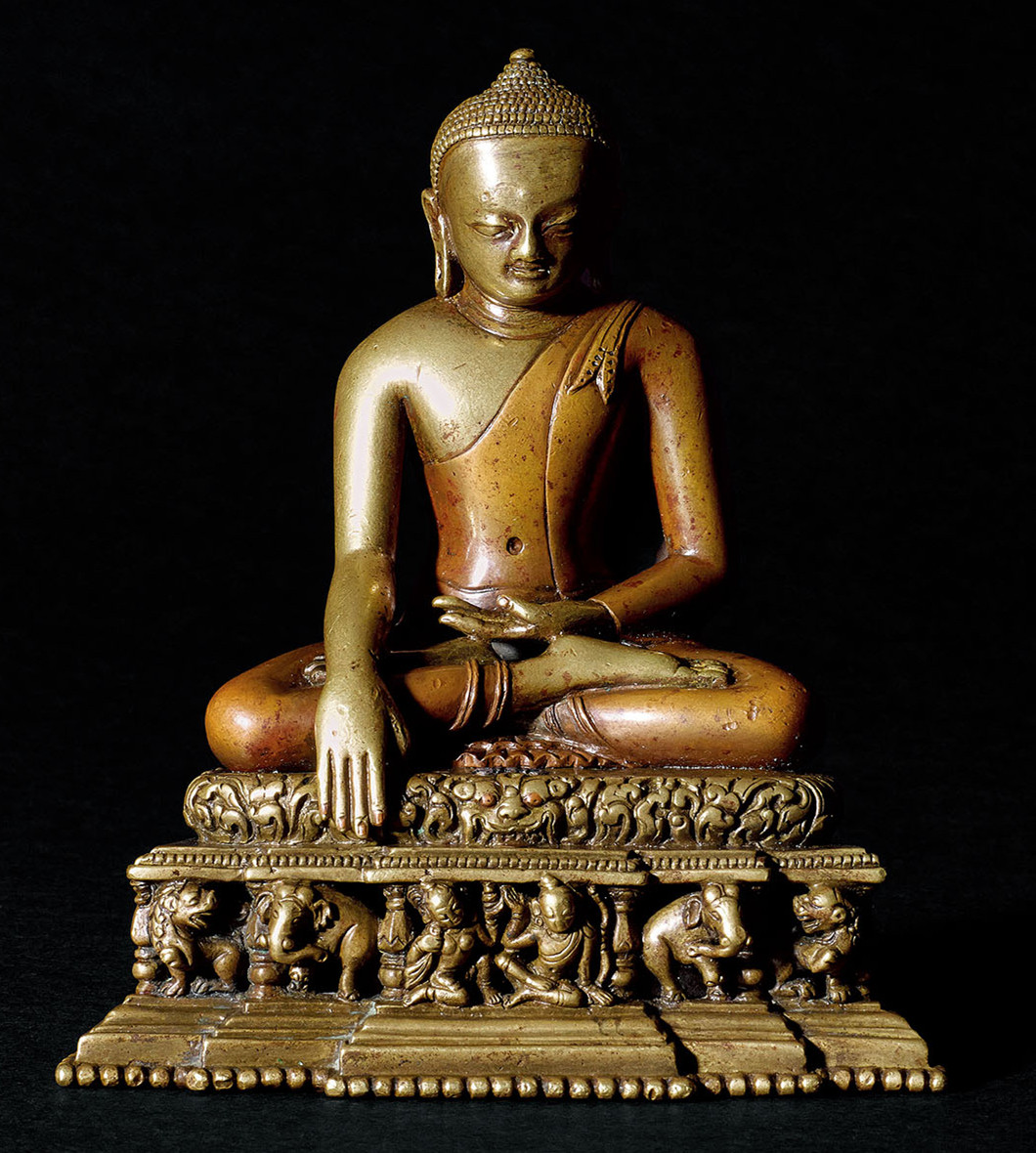
拍品说明尺寸:高12.5cm
著录:王世襄(著)《俪松居长物志·自珍集》,生活·读书·新知 三联书店,2007年3月,第67页,图3.27。 来源:王世襄旧藏。拍卖记录:1.中国嘉德国际拍卖有限公司,2003年11月26日秋季拍卖会,《俪松居长物·王世襄、袁荃猷珍藏中国艺术品》专场,LOT.1171;2.中国嘉德国际拍卖有限公司,2010年5月16日春季拍卖会,《瓷器玉器工艺品》专场,LOT.2705。☆此标的需办理特殊竞投牌
收起
集萃·瓷器专场
中贸圣佳2015秋季艺术品拍卖会
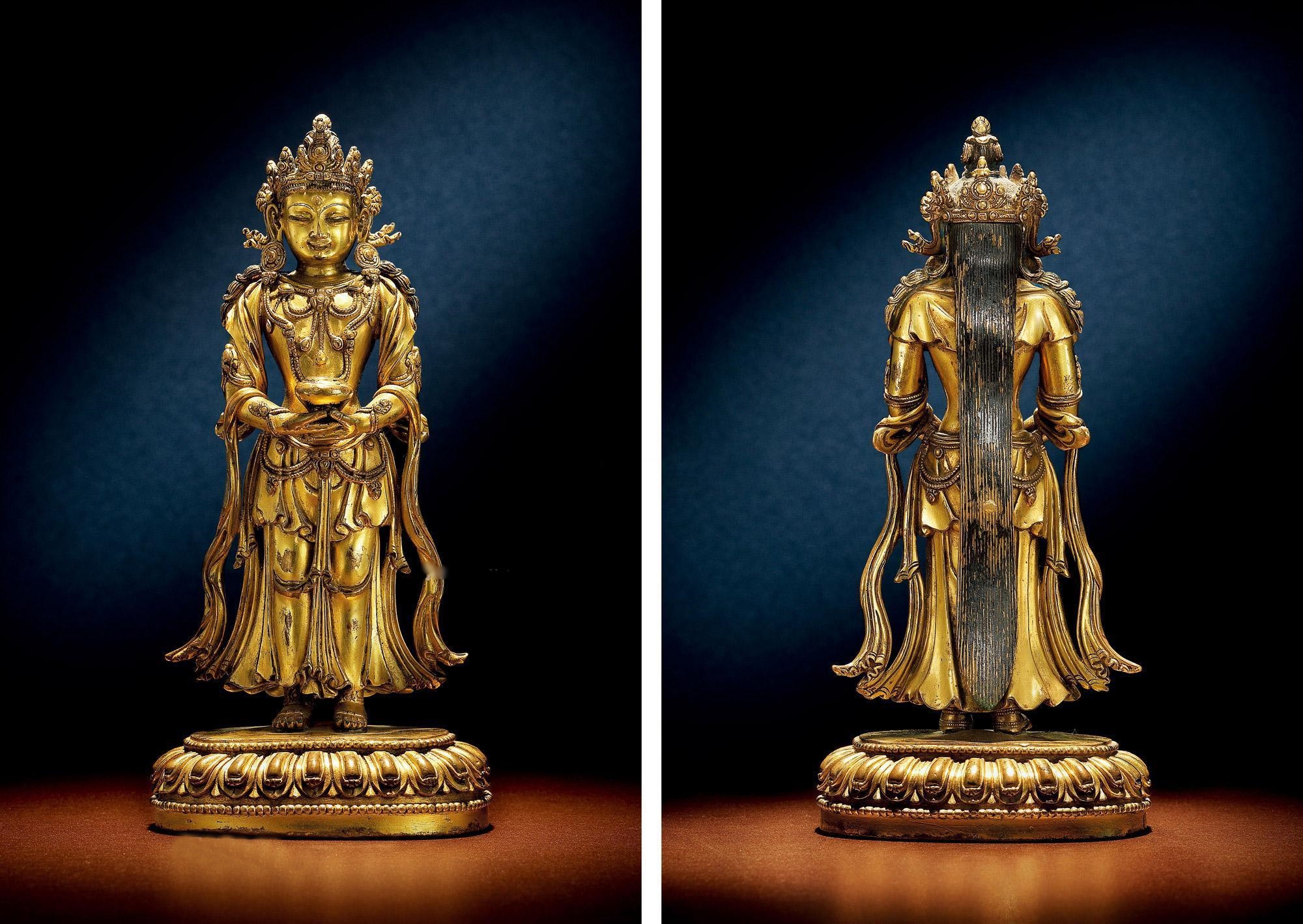
3009 明永乐 鎏金铜无量寿佛
拍品信息
作者 — 尺寸 高18.4cm
作品分类 佛教文物>佛教文物其它 创作年代 明永乐
估价 HKD 8,000,000-12,000,000
成交价
RMB 20,729,880 HKD 25,880,000USD 3,312,640EUR 2,588,000
专场 观佛三昧—中国佛教艺术 拍卖时间 2015-06-03
拍卖公司 佳士得香港有限公司 拍卖会 2015年春季拍卖会
《大明永乐年施》楷书刻款
说明 来源:纽约苏富比,2000年3月23日,拍品87号
头戴五叶宝冠,长发悬地,双手作结定印,手心托甘露钵,全身饰珍宝璎珞,天衣自腕曲折飘下。莲座上自左至右阴刻「大明永乐年施」楷书款识。底板刻有十字交杵纹,边沿密合,似未开过。整体造型优美,比例匀称,为永乐造像中难得一见之佳作。
此尊无量寿佛属于永乐造像中较小型的作品。Speelman旧藏一尊弥勒菩萨像,亦属此型作品,其后于2006年10月7日于香港苏富比拍卖,拍品803号。两尊造像身量相仿,风格却不尽相同,此尊于细节上的处理更显精巧,如钵内甘露的表现手法及足上的装饰,更完整得体现出明初铸造工艺的精湛。
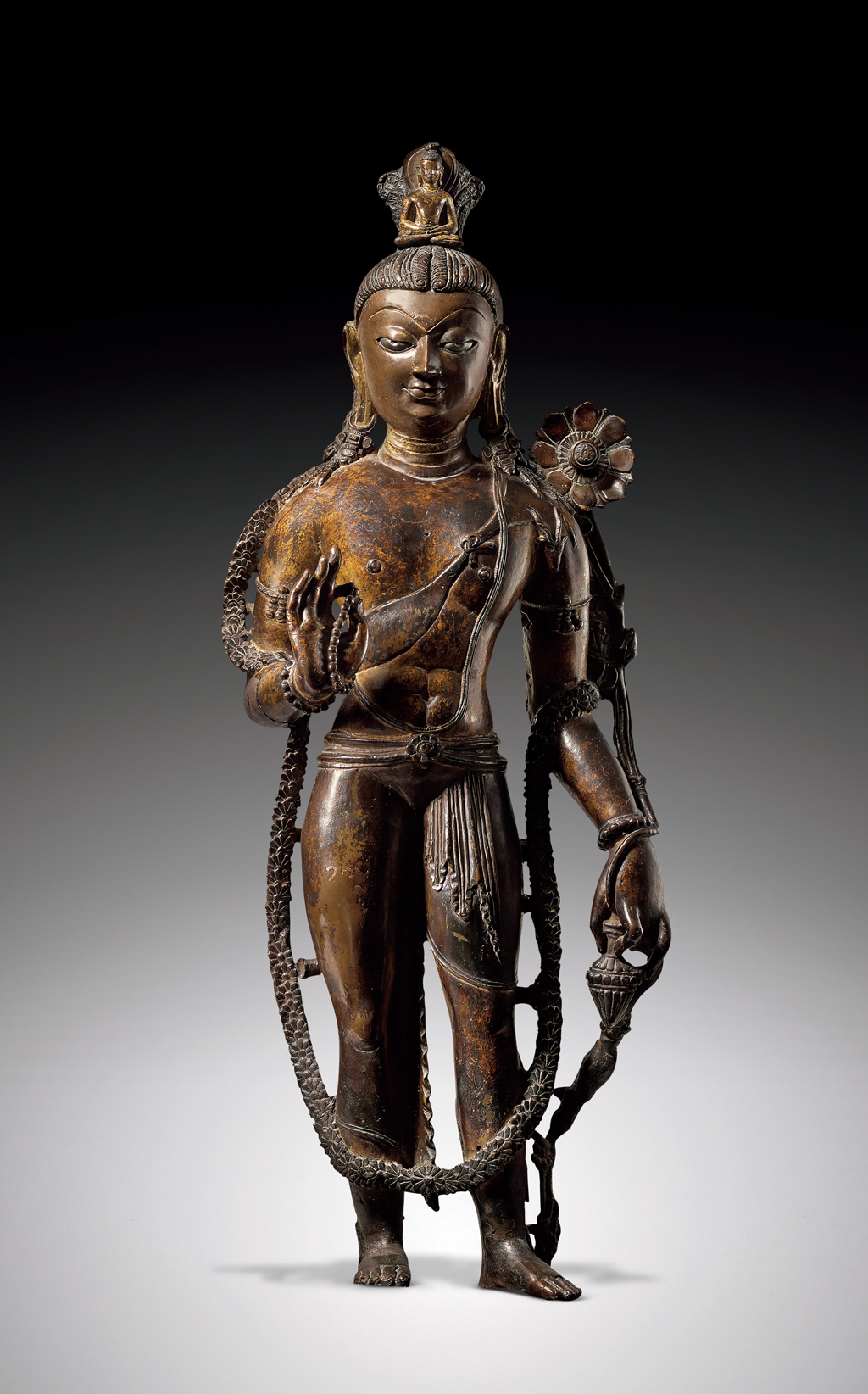
*2610 10世纪 观音菩萨
拍品信息
作者 — 尺寸 高71.8cm
作品分类 佛教文物>佛教文物其它 创作年代 10世纪
估价 咨 询 价
成交价
RMB 23,000,000 HKD 28,714,107USD 3,450,000EUR 2,530,000
专场 伏藏—金铜佛像 拍卖时间 2015-06-28
拍卖公司 北京翰海拍卖有限公司 拍卖会 2015春季拍卖会
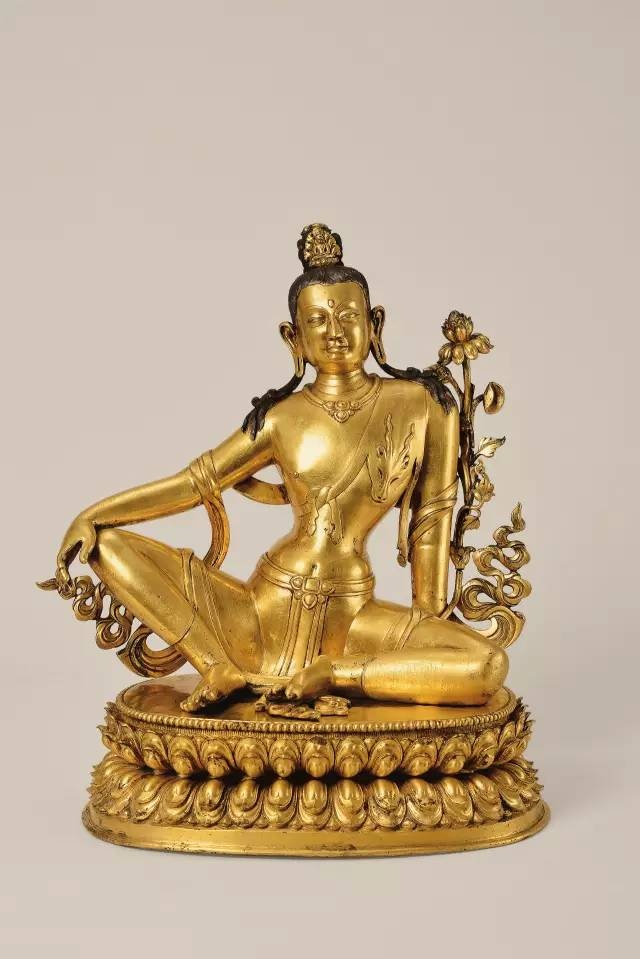
備註:巴黎蘇富比 2013.6.12 Lot157
2015年秋季拍賣會12月8日「自在菩提——中國金銅佛造像、唐卡」專場
在2015年秋季拍賣會中的「自在菩提——中國金銅佛造像、唐卡」專場,118件拍品最終實現總成交額近6489萬元。其中,封面作品,紮實倫布寺風格17世紀自在觀音以2185萬元成交,引發全場關注,超過底價數倍。此尊銅鎏金自在觀音像,以無與倫比的塑形技藝、結合極具張力的藝術表現,展現出觀音菩薩大慈大悲、普度眾生的殊勝形象。其面容俊美、目視遠方,姿態自在而超逸,軀體充滿了動人的柔和感與生命活力。同時,作為一件充分表現札寺造像藝術雋永之美的作品的同時,更為研究札寺造像藝術史提供了極為重要的實物例證,其2185萬的成交價亦證明市場對於此類將藝術價值與文物價值結合於一身的作品之認可。
銅鎏金觀音頭頂束高髮髻,余發編成髮辮垂於兩肩,髻頂飾寶珠,髮髻正面安化佛阿彌陀佛。雙耳垂肩,耳下開有佩戴耳環的方孔。面形方正,雙目平視,形容俊朗,神態慈和。軀體健碩,四肢柔軟結實。上身袒露,戴項圈,左肩斜披象徵慈悲的仁獸皮,形似小山羊;下身着長裙,衣薄貼體,衣紋簡潔。雙臂挽帔帛,帔帛隨性翻卷於腕間,末端飄向空中,線條婉轉流暢。遊戲姿勢坐於雙層束腰蓮花寶座上,左腿橫盤,右腿支起並略向外撇;左手撐於左腿後,並持蓮莖,蓮花隨肩部向上伸展,花朵開於肩頭,右臂向前伸展,手掌撫於右膝上,姿態自然閒適。蓮座造型周正,裝飾繁複講究,蓮瓣飽滿有力,密集環繞蓮座一周。整體造型獨特,姿態舒展,形象生動,法相莊嚴,做工精緻,品相完好,充分展現了觀音菩薩濟世自在的宗教特質。其造型樣式應當來源於漢地的水月觀音,表現觀音菩薩觀照水中月亮的姿勢,喻示菩薩通達空性之理,具足般若大智。

![[临渊阁]天地一家春](https://www.antiquekeeper.ca/wp-content/uploads/2023/04/BW-Erping-1a-17-6-1.jpg)
